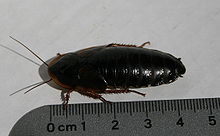- Blaptica dubia
-
Blaptica dubia 
Scientific classification Kingdom: Animalia Phylum: Arthropoda Class: Insecta Order: Blattodea Family: Blaberidae Genus: Blaptica Species: B. dubia Binomial name Blaptica dubia
Serville, 1839The Dubia Cockroach (Blaptica dubia), also known as Orange-spotted Cockroach or Guyana Spotted Cockroach, is a medium/large species of cockroach, measuring about 4.5 cm (1.8 in) long. They are sexually dimorphic; the males have wings while the females have only tiny wing stubs. Adults are dark brown to black with somewhat lighter orange spot/stripe patterning sometimes visible only in bright light. It is said that although the males have wings, they do not fly, they can hover 1-2 inches in the air; however, in practice it has been proven that the males rarely do seem to fly greater distances. Neither adults nor juveniles climb smooth surfaces, though juveniles have been known to climb the silicon seals in aquaria. Dubias are prolific and give birth to between 20 to 40 live young in a month.
The Dubia cockroach is found in Central and South America. They are common from French Guyana and Brazil to Argentina.
Contents
Food and environment
Ideal temperature range is the higher end of a 75–95 °F (24–35 °C) range.[1] They will not breed below 68 °F (20 °C). They will not moult successfully if the humidity is too low. Dubia roaches can tolerate lower humidity than many other roach species.
The Dubia cockroach is omnivorous and a scavenger. They particularly like sweet foods. Good foods for raising Dubia roaches include: carrots, apples, oranges, lettuce (not iceberg or romaine), dry cat/dog food, cereals, fish food, crested gecko meal replacing powder and bearded dragon chow.
Use as feeder insect
Dubia cockroaches have become popular for feeding reptiles and amphibians because they are a high quality herp food source that is easier to raise than crickets. Dubia are a meaty roach with a soft body which contain a much higher ratio of protein to indigestible chitin compared to crickets. They breed in drier conditions than many other roaches and produce little odor. They are calm and easy to handle for feeding. They do not make any noise which is another reason they are becoming much more popular than crickets. Instead of having an escaped cricket forcing you to go "camping" at home, if you drop a roach they are easy to catch.
Compared to other roaches, they are exceptionally poor climbers and cannot climb glass or plastic;[2] they can, however, climb silicone used to seal fish tanks.
Compared to crickets, dubia roaches are quiet, don't smell, don't jump out of the enclosure, are less picky eaters, are more hardy. But they mature more slowly.
Lifecycle
- Mating occurs when the male deposits a sperm packet in the female. This sperm packet inhibits the female from further mating.
- Females then lay an egg sack, they then pull this sack back into themselves to incubate ovovivoparitally.
- Gestation is about one month (28 days).
- The babies hatch inside the female. Between 20 and 40 live young, each about 2 mm long, are produced in each clutch.
- Babies mature in about 4–6 months depending on temperature and food supply.
- Adults live 1–2 years.
Breeding
Substrates[3]
Water supply.
Ventilation is important. Excessive humidity and the resulting mold are detrimental to their health.
Here is a video showing a nice breeding colony.[4]
Many people opt for the simplistic approach to breeding and raising them, vertically oriented egg cartons are arranged in an aquarium, a heat pad is placed underneath, and a fine mesh screen top is placed on the tank (more to keep juveniles in than anything else). Release the roaches into the tank. Feed them a few times a week and mist them with water once a day and within a month you will start to see your colony explode. Within a year your colony will be huge.
See also
References
External links
Categories:- Cockroaches
- Pet foods
- Animals described in 1839
Wikimedia Foundation. 2010.

